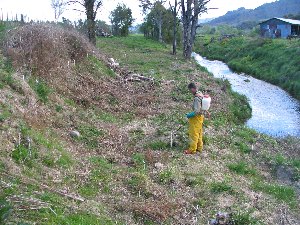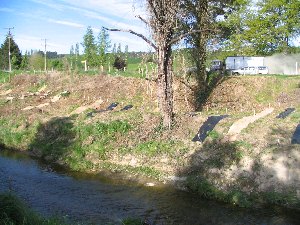Sherry riparian trial progress
Up-date - October 2008
The main purpose of this visit was to plant the Booth trial area, to measure the + and – weed control trial on the N bank at the Bavin’s, and to inspect a possible wetland management site on Lisa Savage’s property.
Species planted at the Booth’s site (all locally eco-sourced):
Rootrainers – 50+: Pittosporum tenuifolium, Olearia avicennifolia, Olearia polita, Hebe salicifolia, Hebe stenophylla (rather thread-bare foliage), Coprosma robusta, Coprosma lucida, Plagianthus regius, Cordyline australis, Cortaderia richardii, Phormium tenax.
Rootrainers – c.20: Podocarpus totara
Potted - 50+, 1.5 l: Carpodetus serratus, Sophora microphylla
Potted - 10, PB3: Nothofagus menziesii, Dacrydium cupressinum, Dacycarpus dacrydioides, Podocarpus totara, Prumnopitys taxifolia.
Species inter-planted at Bavins:
Nothofagus menziesii(4), Dacrydium cupressinum (4), Dacycarpus dacrydioides (4), Podocarpus totara (4), Prumnopitys taxifolia (4), Carpodetus serratus (8), Sophora microphylla (10)
Up-date - April 2008
Looking over the Sherry River, to the 2-year old trial of native species. The main focus of this trial has been how to control competitive weeds during establishment.
The Sherry River environment, with its good soils, high rainfall and relatively mild temperatures, is good for vegetation growth. This means that native plants can grow fast, but so also can weeds, and if these are not controlled, they can easily dominate and completely suppress newly planted native seedlings. In this respect, the most threatening weed species are the sprawling vines, such as old man’s beard, convolvulus, passion fruit and blackberry, which are common in the area. Therefore, it could be deduced that good weed control is likely to be essential for the successful establishment and growth of native species in the riparian areas of the Sherry River.
However, the Bavin trial does question this hypothesis, as native seedling survival after 2 years with no weed control was still 64% and, although this was significantly poorer than in the chemical control treatment (80%), it was not significantly different from survival in the weedmat (67%) and carpet (69%) treatments. Therefore, seedlings can survive without weed control alongside the Sherry River – at least for 2 years.
The height growth and surface area covered by seedlings was best under the ‘mulch’ treatments of carpet and weedmat, especially the latter. The reason for this is unknown, but the additional height and crown diameter growth obtained from the mulches could be significant relative to the native plants managing to suppress weeds in future years. In this respect, it is also important to plant good quality seedlings (see Appendix 1) in order to maximise opportunities for growth. At the Bavin’s, all seedlings were supplied in rootrainers (RX90s) and most met height and root collar specifications. However, RX90s have limited rooting area, and compacted root systems may have contributed to the variable early growth of some species.
The cheapest means of controlling weeds proved to be chemicals or herbicides (at $1.89/m2), but the difference was only 13 cents when compared to the cost of weedmat (6% more expensive at $2.02/m2) and carpet (7% more expensive at $2.04/m2). However, herbicides require regular applications to be effective – in the Bavin trial, four were applied annually. If ‘own’ labour is used at no charge, the chemical treatment becomes more attractive. Herbicide application should be by an experienced operator and only carried out in the right (wind-still) conditions, as spray-drift can be very damaging to native seedlings. In comparison, there are no chemical risks associated with weedmat and carpet, and for the 2-year duration of the trial they were ‘one-off’ treatments which did not need to be repeated. If ‘own’ labour is used at no charge, the chemical treatment becomes more attractive.
Even though, there are advantages to using weedmat or carpet, these two ‘mulches’ are laborious to install and are only practical on flat, smooth surfaces. In addition, if not properly prepared (slots cut for seedlings) and held in place by weights or pegs, they can move over young trees, or lift and allow weeds to establish. Over time, weed growth can be prolific around edges and in the central hole and the slit leading to it. If these are allowed to reach maturity and release seed, the local seed bank in the soil is continually being renewed, whereas with chemicals no weeds can reach maturity and hence the soil seed bank is eventually exhausted – although many weed seeds are disseminated by wind, which can blow them considerable distances.
The Bavin trial has been monitored, with chemical control maintained, for 2 years, after which time many native plants were well over 1 m in height. No more control is intended after this time, and indications are that they might struggle to survive if weed growth continues unchecked. Some plants may grow tall enough to outcompete the grasses, but climbing/sprawling weeds and vigorous woody species such as broom could well remain a problem, and there may be no option but to remove these manually every few years.
Species choice is going to be important in sites with such rapid weed growth, and the faster-growing, more dominant native plants are most likely to succeed. Of the species used at Bavins, the tallest after two years were kohuhu, followed by mountain ribbonwood, cabbage tree and karamu. These four species also had the largest crowns and covered the most ground surface area – and hence had the best chance of dominating the site and suppressing weeds over time. Karamu is a well-known ‘nurse’ species for early site domination and later underplanting with slower-growing, longer-term species, but it has shown itself to be susceptible to hard and/or late winter frosts, which can occur in the Sherry catchment. The same was true for koromiko, and especially wineberry, with the result that many plants were hard hit during the first winter.
In conclusion, there is no simple solution for successfully establishing native species in weedy environments, such as exist alongside the Sherry River. The use of fast-growing species planted as high quality seedlings, followed up with good weed control by means of herbicides, and mulches of carpet and weedmat, will assist early survival and growth rates over the first 2 years. However, further weed control is most likely to be required before adequate and long-term native species dominance of the site is achieved.
Up-date - July 2007
The main purpose of this visit was to measure the 2005 trial, look at possible new sites for seeding trials (Bavin’s) & to see how the new trial site was progressing (Booths).
Personnel: David Henley & Simeon Smaill
We left Nelson, having been there since the 11th July, working on other trials in Golden Downs and Rai Forests. Conditions had been fine and frosty with no wind.
We arrived at the Sherry around 8.30 am and started the measurement of the main trial site (planted 2005), this took approximately 2.5 hours to complete. There had been good growth over the last year with some plants now over 2 m. Once again there is frost damage to karamu (Coprosma robusta) and to a lessor degree on koromiko (Hebe salicifolia) and kohuhu (Pittosporum tenuifolium). These species will recover come spring. Also measured but not part of the trial were koromiko, flax (Phormiun tenax), toitoi (Cortaderia richardii) & purei (Carex secta). The flax, toitoi & purei were all growing well. These should help stabilise the bank over the long term.
We caught up with Nicky Bavin and discussed and looked at potential new sites for a seeding trial over the stock bridge. A decision will be made on our next trip at the end of August, as to which site will be best. Nicky also indicated that the bank opposite the milking shed could be planted. This could be a good site for a community based planting project, if plants are available.
Two of the three sites we looked at would require fencing.
After the Bavin’s we headed up to the Booth’s property to look at the new trial site. The grass that had been sown on the site had established reasonably well but will require another season to achieve the goal of rank grass. Bill had made a start on poisoning the willows and hoped to complete it in the next ten days or so.
The Future
Another visit will be made to the Sherry on August 28-30, 2007. The main jobs then will be to:
- Assess 2006 plantings on the north side of the river at Bavins
- Spray grass at seeding site over stock bridge
- Possibly prepare another seeding site in rank grass opposite
- Collect native seed / litter from Booth’s native forest remnants and sow this (plus kanuka and manuka collected earlier) into sprayed area at Bavin’s
- Inspect site at Booth’s and decide on future management
- Contribute to community planting day - using seedlings from Titoki nursery. The location of this planting has yet to be decided.
Up-date - December 2005
Three months after planting (2 months since the last spray application), the native plants looked in reasonable to good health. The species hit by frost soon after planting (wineberry and karamu) still had 50% or less survival, but many of those still alive were growing from the base. Most of the kanuka had dead tops, but were recovering in their lower halves. The majority of the remaining plants had established well.
Details of the rehabilitation plan at Nicky and Paul Bavin's Property, 'Athelbrook', Bushend Road, Sherry River, Motueka Catchment. ![]() 57 KB
57 KB
 |
 |
Dave Henley applying initial blanket herbicide to the trial site |
Trial site from opposite bank of Sherry river after treatment application. All treatments address weed control around planted natives - using herbicide alone (for 2 years), no herbicide (control), and carpet and weedmat 'mulches'. |
 |
|
Dave Henley alongside herbicide, carpet and weedmat treatments shortly after trial establishment. Native seedlings planted at 1 x 1 m spacings. |
|
Diary notes from December 2005 field visit ![]() 48 KB
48 KB
Contact Lisa Langer or Nick Ledgard